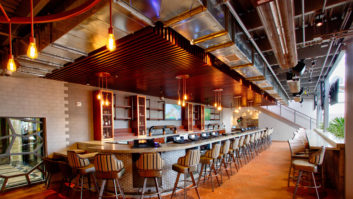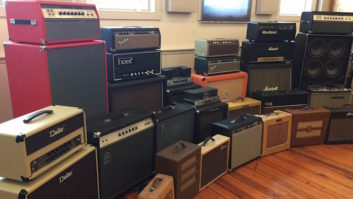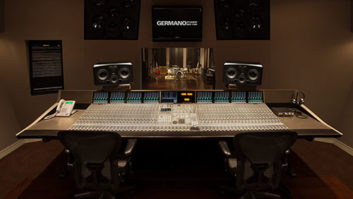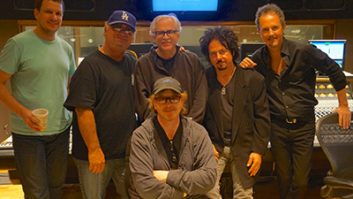Just a few minutes into a conversation with Neil Dorfsman and you get the feeling that he’d be a great guy to hang with. A lot of fine musicians have felt the same way; Dorfsman’s unique array of engineering, production and people skills has connected him with such artists as Sting, Mark Knopfler and Dire Straits, Paul McCartney, Tina Turner, Bruce Hornsby and Bob Dylan, to name a few. Unlike most in the business, he’s equally adept at production and engineering, and has taken home Grammy and TEC Awards in both categories. Among them: a Best Engineered Album Grammy for Dire Straits’ Brothers In Arms with its ultracool single “Money for Nothing,” two Grammys for Producer of the Year (Sting’s Nothing Like the Sun and Bruce Hornsby’s Scenes From the South Side), two additional Best Engineered Album Grammy nominations (for Dire Straits’ Love Over Gold and Paul McCartney’s Flowers in the Dirt), and an Engineer of the Year TEC Award; that same year, he was also nominated for the TEC Award for Producer of the Year. Most recently, he was one of the engineers on the 1999 Grammy winner for Best Pop Album, Sting’s Brand New Day.
I spoke with the amiable Dorfsman by phone as he was holed up in his Westchester County home one bitter cold winter day. He was spending time with his family after wrapping up a project that he’d produced, recorded and mixed: The Edge of Silence by the critically acclaimed Solas, an Irish-American band with deep Celtic music roots.
Um Neil, I’m kind of thrown off by your accent. I’d always assumed you were English.
[Laughs] Most people do. They’re always shocked when they meet me. It’s probably the name. Everybody thinks I’m some furry little British guy, as opposed to a tall, balding New Yorker, but I was born in Manhattan and grew up on Long Island.
And you started your engineering career in New York.
Actually, I first went out to California to try to be an engineer. I was one of those guys with a massive record collection, and I always listened from a producer’s point of view. So I went out to L.A. in the mid- ’70s trying to get a job at a studio. I didn’t know anything or anybody; I just figured that was the place. And I had absolutely no luck. An example: There was an ad in the newspaper to interview for a job with the Beach Boys. And there I was in L.A., dead broke, with no car! I took a bus all the way to Santa Monica from Hollywood, which took about two hours, and the first question of the interview was, “What’s your sign?” I didn’t have a clue, and I didn’t get the job. I also realized at that point that maybe heading west was the wrong direction for me.
Eventually, I went back to New York and got a job at a voice-over studio, recording radio commercials. We had no multitracks. We’d use two 2-track machines, one for stock music, one for the voice-over, and we’d mix and bounce down to a third machine. I was learning, but I was still frustrated. But I kept at it. I sent out about 100 resumes and finally got a job as an assistant at Electric Lady.
I was there about a year when I did a project with Eddie Kramer that ended up getting mixed at what was then the Power Station. I went to help on the mixing, and Bob Walters, the owner, asked me if I would stay on.
A lucky break; Power Station was legendary then.
It was great. Everyone had heard about the place but few people had really seen it — it was like, “They’ve got a Pultec on every channel! They’ve got this giant room, and they’ve got a parking lot inside the building!” All of which was true. I was completely over the moon just to visit there, never thinking they’d actually ask me to stay. I guess Bob must have liked my completely subservient attitude! I was there for several years, then I went freelance and have done that ever since.
Let’s talk about the Solas CD that you’ve just finished up for Shanachie Records. It has a very warm, un-Pro Tools kind of sound.
Funny you should say that; actually, it’s a total Pro Tools record.
Oops. There goes my “golden ears” rep.
It’s my first project recorded start to finish into Pro Tools, which was pretty daunting, because I had my doubts about both sonics and operation.
I’m a huge fan of digital; I have been from day one. I loved the fact that what you heard was what you got, in the sense that every day your tape would sound the same. One of my big frustrations recording with analog is that every day, while you’re overdubbing, your mix sounds different. I don’t know if it’s humidity or temperature or particles on the tape — whatever — it drives me crazy. I don’t get the whole reverence of analog tape at all; once I used a Sony 3348 and that was it for me. And there are even better-quality machines out today, like the Euphonix R1, which I think sounds incredible.
Having said that, I was still very worried about the sonics of Pro Tools. Of course, I’ll never know what it would have sounded like in another format, because my motto has now become, “Don’t A/B.” Because there’s always going to be something out there that you think might sound better technically than what you’re currently using. But, considering the small budgets of most projects these days, you have to make the best of what you’ve got. I’m very curious about gear, and I always like to try new stuff, but for my own sanity, I just put blinders on and go.
Take what you’ve got to work with and make that great. Isn’t that kind of the engineer/producer job description?
What you’re working on at the moment has to become your world. You’re given a certain set of tools, and that’s the way it is. Hence my motto, “Never A/B.”
How was it working at Bearsville, up in Woodstock, New York?
It was great. It’s a really nice place, and you can completely focus on the work because there’s not much else going on. We had two weeks in the barn for rehearsal, which was great. It’s all acoustic music, and the sound of the instruments in this big wooden barn was lovely. It allowed us to hear everything very clearly. Also, the console in Studio A, where we recorded, is an old Neve, which I would rather work on than anything. It’s an early 80 Series that used to be at The Who’s old Ramport Studio, a beautiful-sounding console. We also mixed there, in Studio B, the SSL room.
You definitely achieved that sought-after “larger than the speakers” sound.
That’s great to hear, because I’m still not sure. We had a heck of a time mixing because we had synching problems between Pro Tools and the SSL. I found that when I changed whatever clock I was using, the sound of the record suffered drastically. Which was disconcerting, because I was running on Apogee clocks for the whole of recording, and I thought it was one of the better recordings I’d done. Then when it came to mixing, the clocking was set up a little differently, and the sonics really suffered.
What went wrong?
At first, I didn’t have a video card for my Apogee converters. We had to use an analog multitrack tape machine as the interface between Pro Tools and the SSL 4000 computer, and Apogees are not happy when the wordclock and the positional reference are even the slightest bit off, which — invariably — they are with analog tape machines. The video card allowed both the Apogee and the Studer to clock to house sync via a Lynx, so my positional reference from the tape machine was identical to my wordclock reference.
What was your approach to recording this very acoustic band to a computer?
I took what is for me a completely different approach in recording this album; that is, I hardly EQ’d anything during the entire record. Usually when I’m tracking, I pretty much go for it. I try to make things as punchy as I can so that I start building the structure of the thing sonically. I use that as a production tool, because, if you get the mix sounding strong, you can tell right away whether an overdub is competing sonically and musically, or whether you have enough performance energy. It’s funny, I think I have this reputation as being this audio purist and I’m not at all; I’ve never been hesitant to heavily process stuff while I’m recording. But on this record, I took a pretty pure approach.
You made nice use of ambience.
A lot of that was thanks to Seamus Egan, the bandleader. We worked really hard on arranging the songs, which left space for ambience, much of which came from the room at Bearsville. It’s a beautiful room, really large. I generally recorded with some room ambience, although we cut it down in size quite a bit. They also have EMT plates up there, which sound really good. And I used TC stuff, which I’m a big fan of: the 3000 and M5000. I like very clear reverb, something you can make really long without it starting to sound grainy. I tend to set up a lot of different reverbs at the start of my mix — maybe eight or nine — then I play with things as I go.
Do you set them up any special way?
I’ll use a tone burst or a click to get them nice and balanced, then listen to a voice — something natural and acoustic — to see if they sound too dark. I like to have it all set before I start putting up faders, so I don’t have to spend any time between thinking of something and trying it. I used to work at one studio and had the luxury of assistants who knew what I liked and had it ready when I came in. Now I’m working everywhere, so I usually spend a half-day before we start getting all that set.
Speaking of working everywhere, what’s in the rack you bring with you?
Actually, I’m “Mr. Rackless.” I own an Aguilar bass preamp, an Eventide H3000 and an SSL stereo compressor, which I use on drums. I have a LittleLabs guitar splitter box, which I love because it makes re-amping stuff so easy — and I have a SansAmp. [Laughs] Really, I’ve got nothing. I used to be so into gear; now, I just try to make do with what I’ve got.
What was the instrumentation on the basic tracks, and what was your setup like?
It was one of the more live records I’ve done. The band is incredible onstage, and I thought if I could capture 60 percent of that, we would be in great shape. I still don’t know if we got it as great as they are live.
For most tracks, the instruments were an accordion, or concertina — some sort of squeezebox — a fiddle, an acoustic rhythm guitar, an acoustic or electric melody guitar, electric bass and some sort of drums.
We had homemade booths in the room in kind of a circle, and we built a baffled house for Mick McAuley’s accordions. I was more worried about him leaking onto other things than stuff leaking onto him because he was close-miked with two TLM 170s.
For drums, I used the normal assortment of stuff: [Sennheiser] 421s, AKG 451s, [Shure SM] 56s and 57s — each song was different. We had an amazing drummer, Ben Wittman, for the record. He brought 40 or 50 percussion devices and built all these hybrid drum kits.
I relied a lot on the overheads, which were two, sometimes three, 451s, with -20 pads, which were about five feet above him. I miked everything very closely as well to get some impact. During overdubs, I often miked him with Neumann 254s — about eight feet back and pretty widespread — along with a close mic, generally a Neumann 149.
We had 17 or 18 mics on the drums, which is not unusual for me because I tend to top and bottom mic drums.
Phase-reversed?
I always reverse the phase on the bottom mic and often find that the kick drum also needs to be reversed relative to the overheads. That’s something you’ve got to play with that can totally change the sound of the kit.
What about those really low-frequency drums? There were some tones that sounded like they’d be pinning meters.
Those are Irish Bodhrans and Brazilian hand drums. They were squashed pretty hard while I tracked them and again a little in the mix with the channel compressors on the SSL.
Were you compressing the overall drums and percussion?
Only in the mix. I generally create a “sub-squeeze,” where the natural-sounding drums are also split out to a pretty radical squasher — usually an SSL stereo compressor. The percussion I usually leave untouched, unless I compress it for an effect, like a “sloshy” tambourine.
How did you treat guitars?
I compressed the acoustics a bit, usually with an LA-2A or 3A. The same with clean electrics. On heavier stuff, I’ll often use an 1176. Again, I mult signals a lot so as to get a natural sound mixed in with a “smashed” one. With all the tracks available in Pro Tools, I’ll usually record a DI as well as the amped tracks, keeping them separate so I can re-amp the DI in the mix if something’s not fitting in. No Amp Farm!
Between all the polyrhythms and all the instruments, there’s a lot going on. How did you keep the bass present?
I took it through two different DIs; my Aguilar and the Avalon 737. The Avalon, which has a preamp, compressor and EQ, sounds really good flat. And I really like the tone controls on the Aguilar. I use it when necessary to make the bass more “poky,” or more nasal, or more “bassy.” I also used my modified LA-3A.
The famous “Clearmountain” mod! What is that, anyway?
[Laughs] It’s supposedly just a 75-cent modification — a different capacitor, I think — that somehow makes it sound much better. Ed Evans, back at Power Station, came up with it.
Winifred Horan’s fiddle never sounded harsh, as that instrument sometimes can.
More than with a lot of things, that seems to almost completely depend upon the instrument and the player. I have found that a Telefunken or Soundelux 251 can sound really great on solo violin, but this time we used an M149 as a center mic and two Neumann 254s as a stereo pair. The 254s are vintage, cigar-shaped tube mics, which are incredible; you can have them six feet away from the sound source and it will sound close-miked.
Did you use any outboard preamps?
My secret weapons were a Trowbridge all-tube preamp and compressor. They’re handmade in Ohio by Jack Trowbridge, and they’re incredible — super-transparent, with tons of headroom. We used them on most of the overdubs — vocals, percussion, woodwinds. The Neumann 149 was a particularly great combination with the compressor.
The attack and release on the Trowbridge compressor are really independent, which is unusual; usually, you change one and the other changes. It also has an amazing range of attack and release times. You can squash the heck out of something and not really hear it as compression — just more impact. The mic pre has three amplification stages; if you need more gain, you change stages. It’s got amazing amounts of headroom, and it’s very clear-sounding.
Did you stereo-compress the mix?
I almost always use the bus compressor on the SSL, usually at 4:1. I’ll change the attack and release to suit the material. To me, that thing is the sound of SSL.
Is your Pro Tools system pretty stock?
Yes, except I have my Apogee SE converters, which I think are noticeably better sounding than most of the ones out there.
Did you mix in Pro Tools as well?
I hopefully will never have to mix in Pro Tools. We mixed to DAT with an Apogee PSX100 converter. But I mixed through a half-inch analog machine in record and repro, because I wanted to make sure it didn’t sound too “Pro Tool-ian.” The stereo bus fed the half-inch and, while it was recording, it was playing back into the DAT. I’m not really a fan of how tape changes the sound of your mix like a lot of guys are, but I wanted to hedge my bet and smooth some of the edges and give it some fatness.
Clarity must have been especially challenging on this project with so many midrange instruments: tons of percussion, rhythm squeezeboxes…
You’ve got to choose carefully while you’re recording, because you get used to parts, and you build your arrangement around what’s already on tape. The track can fall apart musically if you start to take that stuff out just because it seems busy.
We made sure things worked acoustically before we started to record, which made my job a whole lot easier. It was totally great that we got to rehearse in the barn where we were playing unamplified. You could really tell if something was going to speak in a song, or carry enough weight. I recorded the rehearsals with one mic direct to DAT, which was really telling.
I generally try to get by with as few parts as are necessary to get the job done. Even if I hear another part, I’d almost rather you hear it in your head when you listen, rather than recording it. That’s a hard trick to pull off; only the really masterful records achieve that sense of being a little understated.
What monitors did you use?
I’ve been through every speaker out there, buying stuff and hating it two months later! The ones I’ve stuck with are ProAc Studio 100s; I switch between them and Auratones. I know that they’re a little bit flattering, so I work around that. The philosophy I learned at Power Station was, “Use the least flattering speaker you can, and it will make you work harder.” I appreciate that, but at a certain point when you’re mixing, you really need to get some pleasure from the speakers and to be able to listen for a long time without fatigue. The ProAcs do that for me. They do need a lot of power; for this project, Richard Rose from Hothouse Amplifiers was kind enough to loan me a really great Hothouse amp, a Model 500 Mosfet.
You’ve gotten awards for both engineering and production, and you seem to move easily between those roles.
Actually, it’s more like I crawl between the two! [Laughs] It’s very difficult to do both. If in doubt, I’ll always sacrifice the engineering for the producing, making sure the performance is right rather than that the sound is “perfect.”
I was trained to work very fast. When I first started at Power Station, I used to do a lot of jingles, and that’s served me well. Sounds shouldn’t take a lot of time. But it’s still demanding. And these days, of course, you’re expected to be an engineer, a producer and a Pro Tools guy!
But when it’s all happening, there really isn’t a better job. I’ve been very lucky to work with some amazing guys who have very strong points of view, and who are really looking for a sounding board, a partner to help push things along. Sometimes I’m a little embarrassed for getting accolades for producing and engineering things that probably would have sounded just as good if I weren’t there! Of course, there are also those projects where you really get in there and get a workout!
Not everyone has the personality to be able to do both kinds of projects.
I try to be what you might call “pro-active,” and to give an honest appraisal of what’s going on. I’ve also tried to develop a better bedside manner over the years! I’m still very excited about the opportunity to be doing this for a living, and, hopefully, when I’m doing a record, I bring good energy to it. I’ve also learned not to get too picky, and to stay positive.
Maureen Droney is Mix‘s Los Angeles editor.
SELECTED CREDITS
PRODUCED, MIXED AND ENGINEERED
Bruce Hornsby:Scenes From the South Side (1988)
Dire Straits:Brothers in Arms (1985), Love Over Gold (1982)
Paul McCartney:Flowers in the Dirt (1989)
Richie Sambora:Stranger in This Town (1991)
Solas:The Edge of Silence (2002)
Sting:Nothing Like the Sun (1987)
Tina Turner:Break Every Rule (1986)
ENGINEERED
Billy Idol:Whiplash Smile (1986)
Bob Dylan:Infidels (1983)
Bruce Springsteen:Tracks (1998), Greatest Hits (1995), The River (1980)
Bryan Ferry:Boys and Girls (1985)
Carly Simon:Hello Big Man (1983)
Def Leppard:Hysteria (1987)
KISS:Love Gun, KISS Alive II (both 1977)
MIXED
Crowded House: ”World Where You Live“ (1986)
Footloose Original Soundtrack (1984)
Jacky Terrasson:What It Is (1999)
Laurie Anderson:Strange Angels (1989)
Marty Stuart:The Pilgrim (1999, five tracks)





